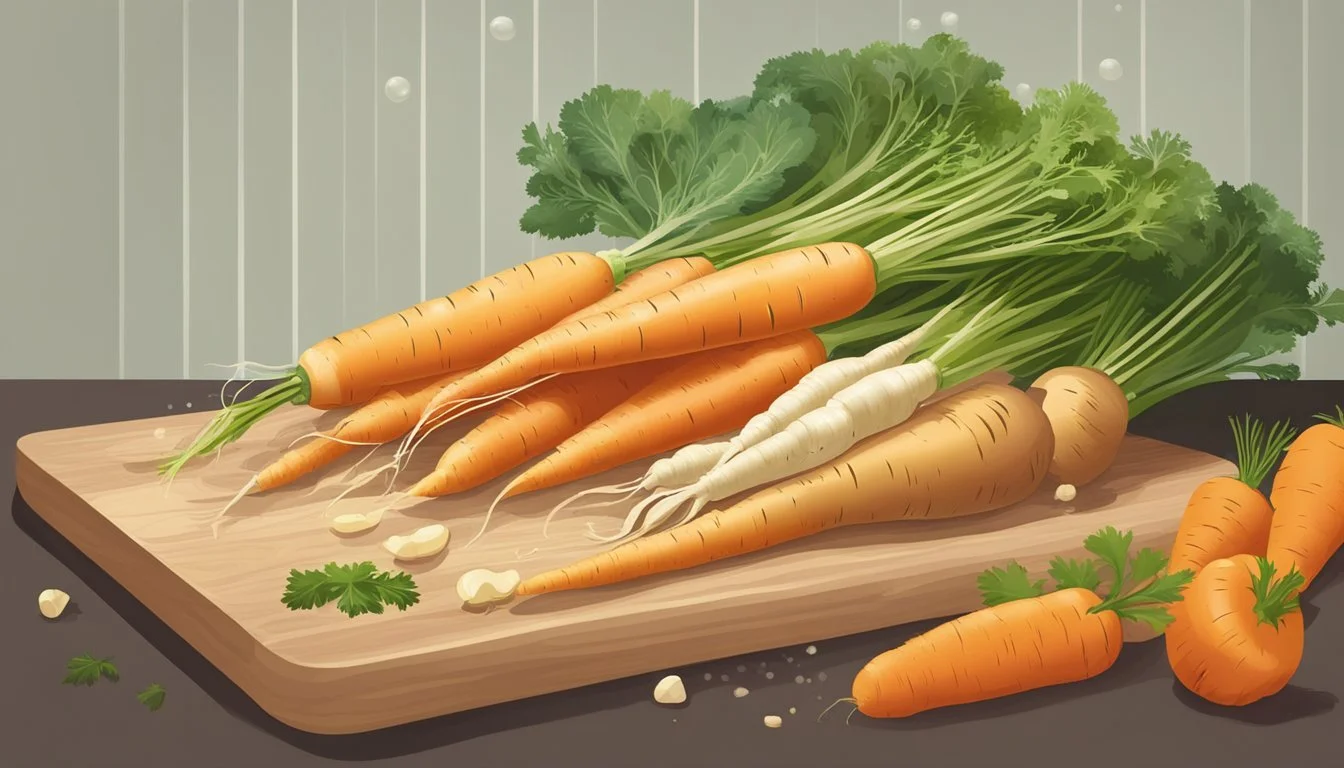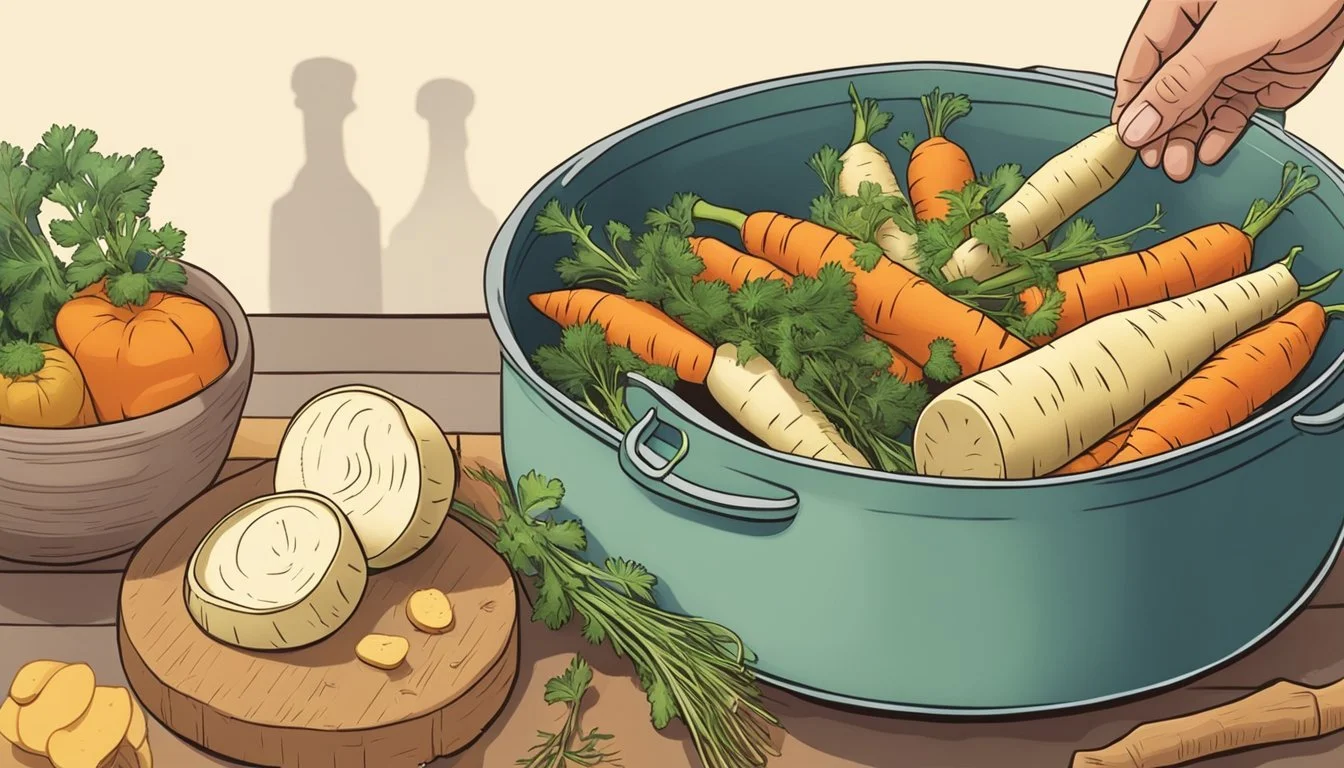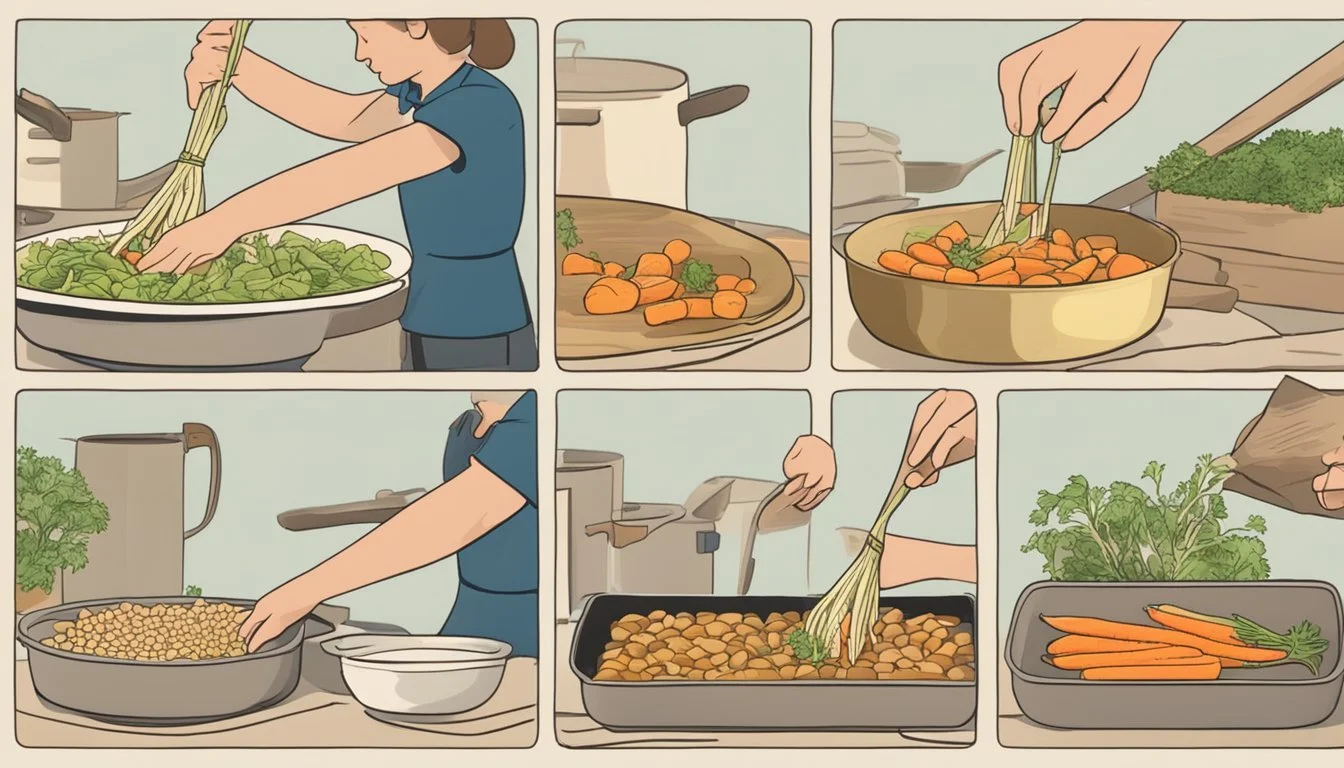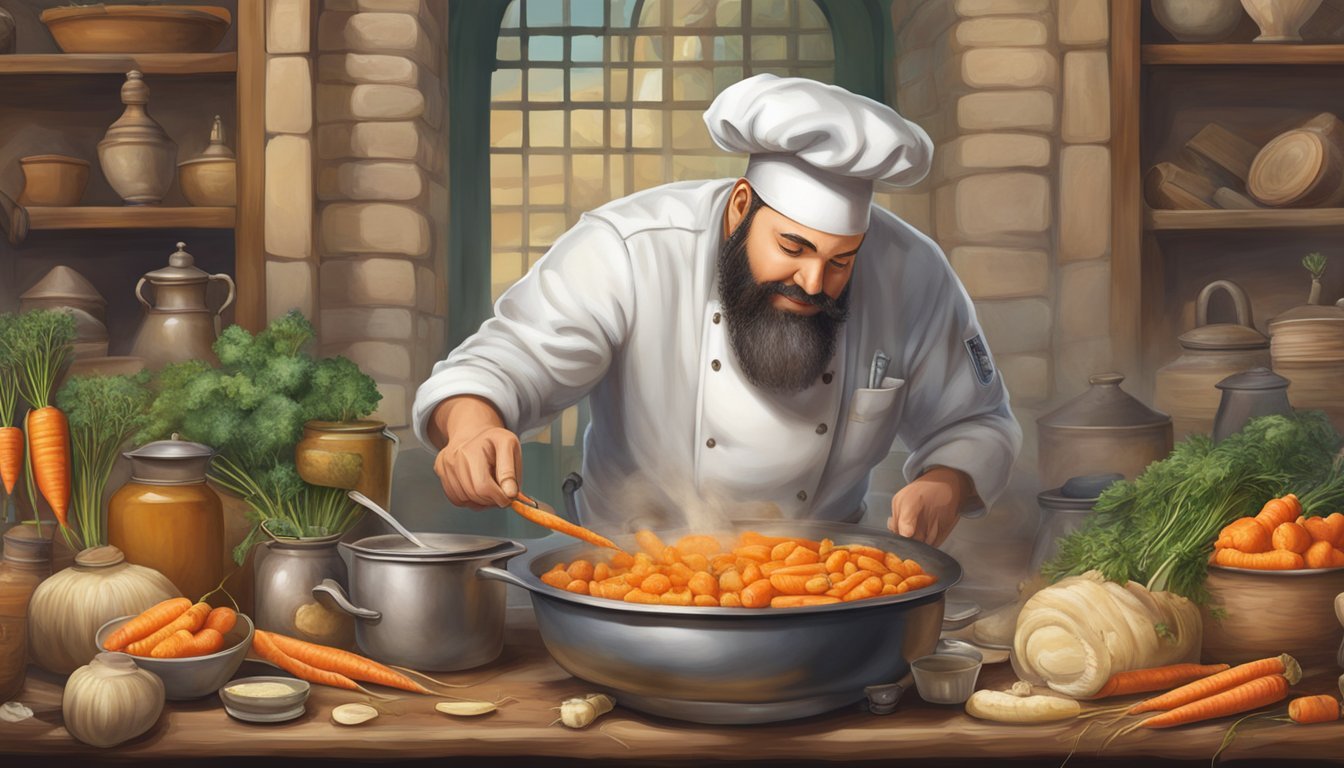How to Substitute Parsnips for Carrots in Stew
Mastering Veggie Swaps
When it comes to creating a hearty stew, the choice of vegetables is crucial to both the flavor and texture of the dish. Carrots (how long do carrots last?) are a traditional ingredient, beloved for their sweetness and vibrant color, which enhances the aesthetic appeal of the stew. However, in some cases, a cook may need to find a replacement for carrots, whether due to dietary restrictions, personal preferences, or simply a lack of carrots on hand. This is where parsnips come in as an excellent alternative. Parsnips bear a close resemblance to carrots in terms of shape and texture, but they offer a slightly different flavor profile with a nuttier and earthier taste.
Substituting parsnips for carrots in a stew can be done effortlessly. Parsnips can be prepared just like carrots; they're peeled, chopped, and then added to the stew to cook until tender. The parsnip's ability to absorb flavors makes it an ideal candidate for stews (What wine goes well with stews?), as they pick up the nuances of the herbs, spices, and the main protein of the stew, be it beef, chicken, or lamb. Their robustness ensures they hold up well during the long cooking process, just like carrots, without falling apart or becoming too mushy.
Nutritionally, incorporating parsnips into a stew instead of carrots offers benefits, too. They are a good source of dietary fiber, vitamins, and minerals. Using parsnips in place of carrots can yield a slightly different texture, given their fibrous nature. They can also influence the stew's overall flavor profile, offering a subtle hint of sweetness along with earthy undertones, thus enriching the complexity of the dish's flavor.
Understanding Parsnips and Carrots
When it comes to choosing the right vegetables for stews, understanding the nuances between parsnips and carrots ensures a successful substitution, considering their nutritional content and unique flavor profiles.
Nutritional Comparison
Parsnips and carrots both offer a range of vitamins and minerals, although their nutritional composition has some differences. Parsnips are higher in dietary fiber, contributing to digestive health, and they provide more than twice the amount of fiber compared to carrots. They are also a good source of vitamin K and folate. Here is a comparative breakdown:
Calories: Carrots generally have fewer calories per serving.
Fiber: Parsnips contain significantly more fiber.
Vitamin K: Parsnips have a higher vitamin K content.
Vitamin C and minerals: Both vegetables are sources of vitamin C and contain a range of minerals.
Nutrient Parsnip (per 100g) Carrot (per 100g) Calories ~75 ~41 Fiber ~4.9g ~2.8g Vitamin K ~22.5µg ~13.2µg Vitamin C ~17mg ~6mg
Table 1: Nutritional comparison of parsnips and carrots per 100g serving.
Texture and Flavor Profiles
Parsnips and carrots possess different textures and flavors, which chefs and home cooks should consider when substituting one for the other. Parsnips have a firmer texture and an earthy, sweet taste that becomes pronounced when cooked, whereas carrots are slightly softer and have a sweeter profile without the earthy undertones.
Texture: Parsnips are firmer; carrots are often softer and cook faster.
Flavor: Parsnips have an earthy flavor with sweet notes. Carrots are sweeter, with less complexity in flavor.
Aroma: Cooking parsnips release a hearty aroma while carrots contribute a subtly sweet and fresh scent to dishes.
These flavor and textural qualities can affect the outcome of a stew, so it's important to adjust cooking times and seasonings to accommodate the desired end result.
Selecting the Right Ingredients
In crafting a stew, selecting ingredients that closely mimic the characteristics of parsnips is essential for achieving a similar flavor and texture profile.
Parsnip Characteristics
Parsnips possess an earthy flavor with a hint of sweetness. They're a root vegetable similar in shape to carrots but have a pale, white flesh. Stews often benefit from parsnips' textural contribution and their ability to absorb and enhance the flavors with which they are cooked.
Recommended Carrot Substitutes
While carrots are the most common and direct substitute for parsnips due to their similar size and shape, other root vegetables can also suffice:
White carrot: Nearly identical in taste to orange carrots, it's an excellent substitute in terms of flavor and texture.
Turnip: It brings a slightly sharper but still sweet taste to the stew.
Celeriac: With a deeper earthy note, it offers a complex flavor profile.
Daikon: Its milder taste can replace parsnips, especially if it is cut to mirror the size and shape of parsnips.
Seasonal Considerations
During winter, root vegetables are at their peak and make the best substitutes for carrots in stew. They can withstand long cooking times and complement the hearty nature of winter dishes. Using seasonal produce ensures maximum freshness and flavor adherence to the desired profile of the original dish with parsnips.
Preparing Parsnips for Stews
Before incorporating parsnips into stews, one needs to prepare them properly. This involves cleaning, cutting, and deciding whether to pre-cook them to ensure they blend well with the other stew ingredients.
Cleaning and Cutting Techniques
Cleaning: Begin by thoroughly washing the parsnips under cold running water to remove any dirt or debris. Peel the outer skin using a vegetable peeler to expose the fresh flesh. It's essential to peel parsnips, as their skin can be tough and woody, which is not ideal for a tender stew.
Cutting: Once cleaned, cut the parsnips into even-sized pieces to ensure uniform cooking. This is done by:
Trimming off the top and bottom ends of the parsnips.
Slicing them in half crosswise, separating the thick upper part from the thinner lower part.
Cutting the thicker part into quarters lengthwise and the thinner part into halves, if necessary.
Chopping all the pieces into roughly one-inch segments for balanced cooking and easy eating.
Pre-cooking Strategies
Pre-cooking parsnips can enhance their flavor and texture in a stew. This can be done by either boiling, steaming, or roasting.
Boiling: A quick boil until they are just tender can be sufficient, as they will continue to cook in the stew. This method is effective if the cooking time for the stew is relatively short.
Steaming: Steaming parsnips retains more nutrients than boiling and ensures they are not waterlogged before adding to the stew. This method is suitable if one prefers parsnips with a firmer bite.
Roasting: Roasting parsnips before adding them to the stew can provide a richer flavor. Simply toss the cut parsnip pieces with oil, salt, and pepper, and roast in a preheated oven at 400°F (200°C) until they start to caramelize, which usually takes around 20 minutes.
When using parsnips as a substitute for carrots in stews, keep in mind that their texture and flavor will differ slightly. Parsnips are naturally sweeter and may become softer than carrots when cooked. Adjusting the cooking time and considering their unique characteristics will help in achieving a balanced and flavorful stew.
Cooking the Stew
When substituting parsnips for carrots in a beef stew recipe, cooks need to account for parsnips' cooking behavior and unique flavor, ensuring it mingles well with other components like beef stock and seasoning.
Adjusting Cooking Times
Parsnips, similar to carrots in density, may require slight adjustments in cooking time. If the parsnip is larger or particularly fibrous, it may need additional time to soften. For uniform cooking, one should chop the parsnips to a size comparable to other vegetables in the stew.
Parsnip Size: 1-inch pieces
Cooking Time: Test for tenderness after standard carrot cooking time
Balancing Flavors
While parsnips bring a sweet and earthy tone to stews, they have a more distinct flavor compared to carrots. To ensure a balanced taste profile, it may be necessary to alter seasoning slightly.
Adjusting for sweetness: Reduce any added sugars
Bold seasoning like rosemary or thyme can complement the parsnip's flavor
Consider a touch of acidity, such as a splash of red wine or vinegar, to balance the sweetness.
Alternative Cooking Methods
Parsnips can be prepared using various cooking methods to enhance their flavor and texture before adding them to the stew. One might roast parsnips to bring out their sweetness, or if the stew's recipe calls for a pureed consistency, parsnips can be boiled and mashed.
Roasting: Enhances sweetness, add roasted parsnips during the last 30 minutes of stewing.
Mashing: Boil and mash for adding thickness to the stew.
Slow Cooker: Add parsnips at the beginning if using a slow cooker; they will hold their shape over long cooking periods.
Remember that the goal is to make parsnips a delightful stand-in for carrots without compromising the hearty flavors and textures traditionally expected in beef stew.
Serving and Presentation
When substituting parsnips for carrots in stew, one should be mindful of how this swap can influence the presentation and the complementary nature of side dishes. Parsnips' slightly sweet and nutty flavor can enhance the depth of the stew, making it a sumptuous main dish that invites a variety of sides and garnishes.
Pairing with Accompaniments
Roast Potatoes: A side of crispy roast potatoes seasoned with rosemary and thyme complements the earthy notes of the parsnips.
Mashed Potatoes: For a smoother texture, serve the stew with creamy mashed potatoes, using butter and a hint of garlic for added richness.
Noodles: Egg noodles or a simple pasta can serve as a base, soaking up the stew’s flavorful juices.
Rice: Plain rice or a herb-infused pilaf makes for a lighter, but no less satisfying pair to a parsnip-laden stew.
Garnishing and Plating
Parsley: Chopped parsley sprinkled atop the stew adds a fresh and vibrant contrast.
Thyme: Sprigs of thyme can be used as an aromatic garnish that echoes the stew's seasoning.
Flavorful Oils: A drizzle of a high-quality olive oil or a rosemary-infused oil can elevate the dish with a hint of luxury.
To serve, ladle the stew into a pre-warmed bowl ensuring a generous amount of parsnips is visible, and arrange chosen accompaniments thoughtfully around it. The garnishes should be applied just before serving to preserve their texture and aroma.
Understanding Substitutes
When substituting parsnips for carrots in stew, it's important to consider how other vegetables, legumes, and grains can influence flavor, texture, and cooking times.
Other Vegetable Replacements
Vegetables can serve as practical substitutes for carrots, each bringing its unique characteristics to a stew. Common replacements include:
Squash: Varieties like butternut and acorn can be roasted or added to stews for a sweet, hearty flavor.
Sweet Potato: Offers a similar texture and sweetness, ideal for stews.
Radish: Provides a spicy kick and can maintain its texture nicely.
Zucchini: Adds a light, summer squash flavor, best added towards the end of cooking to maintain texture.
Celery: (how long does celery last?) Imparts a mild, aromatic flavor and can add a satisfying crunch if not overcooked.
Potato: A classic stew staple that adds starchiness and a neutral taste.
Beets: Delivers deep color and an earthy sweetness.
Jicama: Provides a crunchy texture with a mild, sweet flavor.
Cabbage: Can be shredded for a subtle sweetness and additional bulk.
Utilizing Legumes and Grains
Legumes and grains can enhance stews with their texture and absorption of flavors. They include:
Beans: Such as navy or cannellini, beans add protein and a creamy texture.
Lentils: Cook quickly and come in various colors, each offering a earthy flavor.
Barley: Adds chewiness and expands to create a fuller stew.
Quinoa: A protein-rich grain that provides a slight nuttiness.
Rice: Absorbs flavors from the stew and can alter the thickness.
Noodles: Can be added for a twist on traditional stews, providing a satisfying chew.
Choosing among these options depends on a cook's desired outcome in both taste and texture, as each substitute interacts distinctively with other ingredients in a stew.
Dietary Considerations
When considering substituting parsnips for carrots in a stew, it's important to take into account dietary needs and nutritional impacts. Selecting proper vegetable alternatives, such as salsify or celery root, can ensure that dietary preferences are met without compromising on health.
Vegan and Vegetarian Options
For those following a vegan or vegetarian diet, root vegetables are an excellent source of nutrients and variety. Parsnips, similar to carrots, are naturally vegan and fit perfectly into plant-based diets. They offer a subtle sweetness and a good source of dietary fiber. Vegans and vegetarians might also consider kohlrabi or celery root as they are compatible with this dietary profile and can add unique flavors and textures to stews, soups, or mash.
Parsnip: A close relative to the carrot, providing a slightly spiced flavor.
Celery Root (Celeriac): Offers a nutty taste, ideal for enhancing vegetable stews.
Kohlrabi: Adds a mild, sweet turnip-like taste to dishes.
Low-Calorie Alternatives
Individuals looking for low-calorie options while maintaining the hearty nature of stews can effectively use parsnips. Parsnips have slightly fewer calories compared to carrots and are a healthy choice full of vitamins and minerals. Salsify and water chestnuts can also serve as low-calorie, yet nutritious, additions to a stew with their ability to mimic the texture of traditional stew vegetables.
Parsnip: Provides 75 calories per 100 grams, contributing to a lower-calorie count.
Salsify: Known as the oyster plant, it's lower in calories and may enrich stews with a hint of artichoke flavor.
Water Chestnuts: With their crunchy texture, they are low in calories yet high in water content, making a satisfying addition without adding too many calories.
Historical and Cultural Context
Substituting parsnips for carrots is steeped in historical and culinary traditions. This section provides insights into the origin of these root vegetables and their significance in classic recipes.
The Origin of Parsnips and Carrots
Parsnips have been cultivated since antiquity and were once a staple before the potato became widespread in Europe. They are often confused with the Peruvian parsnip, which is botanically different. Originally, parsnips were used for their natural sweetness before the widespread use of cane sugar.
Carrots have a rich history as well, with evidence suggesting their cultivation started in Persia. Historically, the orange carrot, which is ubiquitous today, was developed in the 17th century in the Netherlands; prior varieties were of different colors, including purple, red, white, and black.
Culinary Traditions
Parsnips and carrots share a culinary background in that both have been prominent in classic and comforting recipes. Carrots are a fundamental component of mirepoix, a flavor base for countless stews and soups across various cuisines. They often feature in well-known dishes like pot roasts and carrot cake, which is cherished for its moist texture and spicy flavor profile.
Parsnips also hold their own in traditional cooking, being central to many a hearty stew and mash. In replacing carrots with parsnips in stew, the former's slightly spicier and nuttier flavor introduces a different dimension to well-known dishes. Despite changes in dietary preferences over time, parsnips remain a marshland plant that continues to endear itself as a root vegetable in various comforting, classic recipes.
Food Science
In substituting parsnips for carrots in stews, it is essential to understand the chemical composition of their flavors and the effects of various cooking methods on these root vegetables.
Chemical Composition of Flavors
Parsnips and carrots both contribute a sweet, earthy flavor to dishes, but their chemical makeup differs slightly, leading to distinct taste profiles. Carrots contain high amounts of beta-carotene, which imparts a sweet taste and signature orange color. On the other hand, parsnips have less beta-carotene but are rich in other flavor-enhancing compounds such as starch.
Carrot
Sweetness: Primarily from "sucrose"
Color: High levels of "beta-carotene"
Parsnip
Peppery Taste: Presence of "volatile compounds"
Aroma: More complex due to a mix of "esters" and "alcohols"
These differences affect not just the flavor but also the aroma when cooked. Parsnips tend to have a more peppery taste and a more pronounced aroma, enriching a stew's flavor profile with complexity.
Effects of Cooking Methods
The texture and taste of both parsnips and carrots are transformed through cooking, which can alter their original chemical composition. Slow cooking methods such as stewing or braising are particularly relevant for these vegetables.
Parsnip:
Texture: Becomes softer and can break down if overcooked
Flavor: The peppery taste can mellow, blending well with other stew ingredients
Carrot:
Texture: Retains firmness longer than parsnips, offering a slight resistance when bitten
Taste: Stewing enhances the natural sweetness
Both root vegetables caramelize when subjected to heat, releasing natural sugars and deepening the flavor. Maintaining moderate heat allows parsnips to soften and release their subtly peppery flavor without overwhelming the stew's overall flavor profile. Carrots, by contrast, add sweetness and color, creating a familiar backdrop for the stew. Adjusting cooking times ensures that the replaced parsnips offer a texture that parallels the expected tenderness of carrots, providing an equally satisfying mouthfeel.









